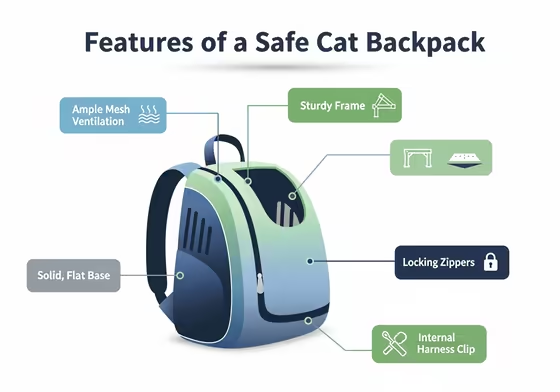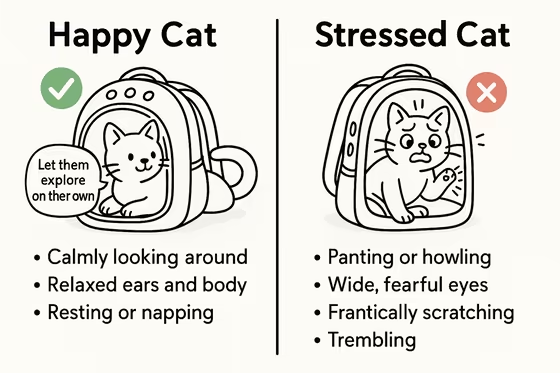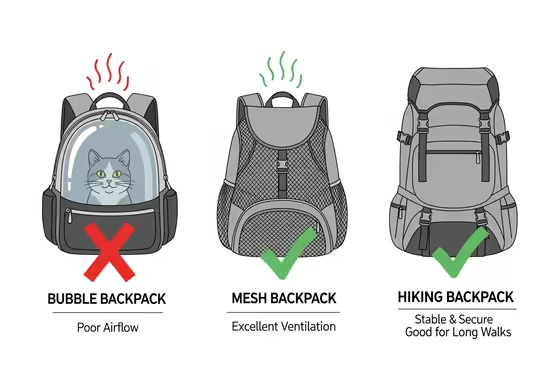Are Cat Backpacks Safe?
So, Are Cat Backpacks Safe?
Cat backpacks can be safe, but it depends on three main things. You need a good quality backpack and a cat with the right personality. You also have to get them used to it first .

A backpack can be a great way for an indoor cat to see the outdoors. But there are risks, like overheating, escaping, or your cat getting really stressed.
A backpack might keep your cat inside, but it could still be unsafe. For example, a bag with bad airflow can cause heatstroke. Forcing a scared cat inside is also a bad idea.
What to Look for in a Safe Cat Backpack
The design of the backpack is the most important part of keeping your cat safe. Here are the features you should look for.

Good Airflow is Most Important
Good airflow is the top safety feature. It lets your cat breathe easily and keeps them from overheating. Cats can't sweat well, so they can get heatstroke quickly in a stuffy bag.
A safe backpack needs lots of ventilation, like big mesh windows or plenty of air holes. Make sure the vents can't be blocked if your cat lies down.
Those "bubble backpacks" with the clear plastic dome can be a problem. The plastic traps heat like a greenhouse, which is dangerous for your cat. Some owners have said these backpacks can "cook your cat" on a warm day.
Also, most cats prefer to hide when they're in a new place. The bubble makes them feel exposed and can add to their stress. It's better to choose a backpack with lots of mesh for better airflow.
A Sturdy Frame and Solid Base
The backpack needs a strong frame so it doesn't collapse on your cat. A flimsy bag can be scary and unsafe for them.
It should also have a firm, flat bottom. A sagging base makes it hard for your cat to keep its balance, which is stressful.
Look for strong materials and good stitching. Reading reviews can help you avoid the cheap, floppy backpacks that don't hold their shape.
Features to Prevent Escapes
- Secure Zippers: A smart cat can push open normal zippers. Look for bags that have locking zippers or clips to keep them from being pried open.
- Internal Harness Clip: A short leash inside is a great backup safety feature. You should always attach this clip to a harness, never to a collar. Attaching it to a collar is dangerous and could choke your cat if they try to jump out.
- Durable Materials: The fabric should be scratch-proof so your cat can't claw its way out. A waterproof material is also good for dealing with weather or accidents.
Making Sure Your Cat is Happy and Comfortable
Do Cats Even Like Backpacks?
It really depends on the cat. Some cats might enjoy it, while others will hate it.
It's not cruel if your cat seems to like it and you introduce it slowly with treats. But forcing a scared cat into a backpack is cruel and can damage your bond with them.
Cats naturally like small, enclosed spaces because it makes them feel safe . A good backpack can feel like a mobile den where they can watch the world.

Signs of a Stressed Cat
Watch your cat's body language. A stressed cat might:
- Howl, hiss, or meow constantly
- Pant (this can be from stress or overheating)
- Shake or tremble
- Frantically try to scratch its way out
- Have an accident in the bag
Signs of a Happy Cat
A comfortable cat will:
- Look around calmly with relaxed ears
- Rest or even nap inside
- Go into the backpack on its own at home
Be careful with purring. Cats sometimes purr to comfort themselves when they are scared or in pain, so don't assume it means they're happy.
How Long is Too Long?
Cat backpacks are only for short trips. They don't have room for a litter box, food, or water.
Most experts agree that a cat shouldn't be in a backpack for more than a couple of hours. Any longer increases the risk of stress and dehydration.
This means a backpack is good for a walk in the park. It's not meant for an all-day trip or for flying .
How to Carry the Backpack for a Smooth Ride
The goal is to have your cat walk into the backpack on its own. If you have to put them in, be gentle and support their whole body.
Backpacks can be bouncy and unstable, which can make a cat anxious. To fix this, look for a backpack with chest and waist straps .
These straps aren't just for you. They hold the backpack steady against your body, which gives your cat a much smoother ride. You can also wear the backpack on your chest, which lets you keep an eye on your cat and help them feel secure.
Getting Your Cat Used to the Backpack
Never force an unwilling cat into a backpack. You need to introduce it slowly with a positive approach.

Step 1: Make a Good First Impression
Leave the new backpack on the floor with the door open. Let your cat check it out on their own time.
Put a favorite blanket , one of your t-shirts, or some catnip inside. This makes the new object smell familiar and safe.
Step 2: Make it a Happy Place
Use special treats that your cat loves to build a good association with the backpack. Start by putting treats near it, then just inside the door, and then all the way in the back.
Praise and reward your cat for any interaction, even just sniffing it. A great way to build a positive link is to start feeding your cat their meals inside the open backpack.
Just don't trick them. Luring your cat in with a treat and then quickly zipping it shut will break their trust.
Step 3: Practice Short Trips Inside
Once your cat is comfortable inside, gently zip the door for just a few seconds, then open it and give them a big reward. Slowly work your way up to longer periods.
Next, try lifting the backpack an inch off the floor, then put it down and give a treat. After that, try walking around the room with the backpack on your chest.
When you're ready to go outside, start very small.
- First, take two steps out the front door, then go right back in and reward your cat.
- Next, walk to the end of the driveway and go back inside.
- Slowly make the trips longer as your cat gets more comfortable.
What if My Cat Freaks Out?
If your cat starts to show signs of stress, you're moving too fast. Go back a step in your training and try again in a few days.
If you must take a stressed cat somewhere, you can use calming pheromone sprays on their bedding. Covering the backpack with a blanket can also help reduce what they see.
How to Choose the Right Backpack
What's the Best Type of Cat Backpack?
The best backpack is one that is safe and comfortable for your cat, not just one that looks cool. Bubble backpacks are popular but can overheat easily.

Backpacks with lots of mesh offer much better airflow, making them a safer choice. Just make sure to get a well-made one with a sturdy frame that won't collapse.
Think about your cat's personality. A shy cat might prefer a bag with more privacy, while a very confident cat might be okay with more windows.
Finding the Right Size
- Your cat should have enough room to stand up and turn around, but not so much that they slide around inside. Always measure and weigh your cat before you buy a backpack.
-
For bigger cats, you'll need a specialized large-cat backpack. Check the weight limit and make sure it has a strong frame to support your cat.
- Some popular options for larger cats include "The Fat Cat" and "The Explorer."
- Putting two cats in one carrier isn't usually recommended. If you do, make sure they are small, get along well , and their combined weight is under the limit.
Backpacks for Hiking vs. Flying
For Hiking
For hiking, you'll want a backpack with padded shoulder straps, plus chest and waist straps for stability. Look for durable, water-repellent fabric and extra pockets for supplies.
For Air Travel
Flying is different. The backpack must be "airline-approved," which means it has to fit under the seat in front of you.
Most hiking backpacks are too tall and rigid for planes. Airlines usually require soft-sided carriers that can squish down a bit.
The size rules are strict and different for each airline , like for American or United , so always check their policy before you fly.
Backpacks Compared to Other Carriers
Backpacks vs. Hard and Soft Carriers
For trips to the vet, the safest and best option is a hard-sided carrier with a top that comes off . This lets the vet examine your cat without having to pull them out, which is much less stressful.
Vets often find backpacks difficult to work with. It’s hard to get a scared cat out of a backpack, and they can’t be easily sanitized.
While a backpack might be convenient for you to carry, it can make the actual vet visit harder for your cat and the vet staff.
Backpacks vs. Strollers and Slings
- Cat Strollers: These are a great choice for comfort. They provide a smooth ride , are roomy, and are perfect for older cats or long walks on flat ground.
- Cat Slings: These soft pouches keep your cat very close to your body, which some cats find comforting. However, they aren't very secure and a cat could easily escape, so they're only for very calm cats in safe areas.
Carrier Comparison
| Carrier Type | Best For | Good for Vet? | Main Concern |
|---|---|---|---|
| Hard-Sided Carrier | Vet visits, car travel | Excellent (Vet Preferred) | Can be stressful if not trained |
| Soft-Sided Carrier | Air travel, calm cats | Poor | Escape risk, hard to clean |
| Backpack Carrier | Walks, public transit | Not Recommended | Overheating, bouncing |
| Cat Stroller | Long walks, older cats | Good | Bulky, expensive |
| Sling / Pouch | Calm, clingy cats | Not Recommended | High escape risk |
Common Questions About Cat Backpacks
Can you take a cat to the vet in a backpack?
You can, but vets don't recommend it. It's hard to get a cat out for an exam, and the bouncing motion can add stress before the visit. A hard-sided carrier that opens from the top is always the best choice for the vet.
Are cat backpacks allowed in stores or on public transit?
It depends. Most stores like Target only allow service animals. Pet stores are fine, but for other stores, you need to call that specific location and ask.

Most public transit systems, like the subways in Chicago and New York , do allow pets as long as they are in a fully enclosed carrier like a zipped-up backpack.
What can I use if I don't have a cat carrier?
Never let your cat roam loose in a car because it's very dangerous. In an emergency, you could use a gym bag with mesh sides for ventilation. You could also secure two laundry baskets together, one on top of the other.
Do not use a regular school backpack, as it has no airflow. These are only for emergencies; every cat owner should have a proper carrier.
What do vets think about cat backpacks?
Vets see them as a fun tool for the right cat, not as a replacement for a normal carrier. They are concerned about overheating in bubble packs and the stress caused by unstable bags. Your cat's safety and comfort should always come first.
Final Thoughts
Whether a cat backpack is safe really comes down to the choices you make as an owner.

- Choose the Right Product: Pick a backpack with great ventilation, a strong frame, and a solid base. Safety for your cat is more important than how the backpack looks.
- Take Time to Train: Introduce the backpack slowly with lots of treats and praise. Never force a scared cat into it.
- Know Your Cat: Pay attention to your cat's body language. If they consistently seem stressed, a backpack isn't the right tool for them.
A good backpack can be a great way for a confident, well-trained cat to see the world on short trips. But for vet visits or car rides, a sturdy, hard-sided carrier is always the safer and better option.